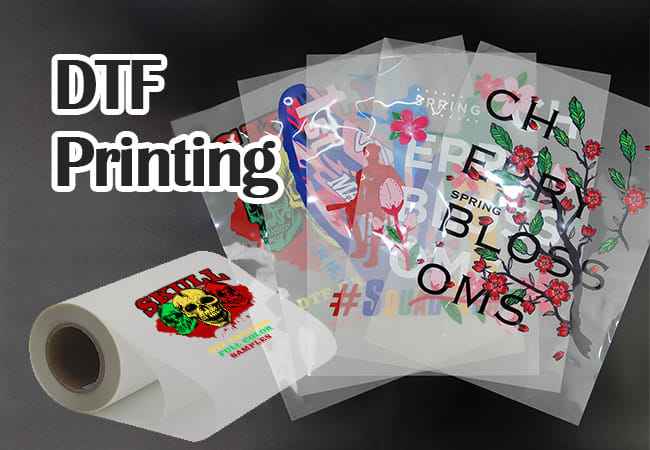Taking advantage of the Power of DTF Printing: Strategies for High-Quality Material Styles
Taking advantage of the Power of DTF Printing: Strategies for High-Quality Material Styles
Blog Article
Understanding DTF Printing: Idea for Getting Vibrant and Durable Prints
On the planet of fabric printing, achieving dynamic and sturdy prints is a coveted skill that can boost the top quality of your output. Grasping DTF (Straight to Film) printing needs a mix of technological knowledge, precision, and attention to information. From selecting the ideal products to tweak print settings and improving post-printing ending up techniques, there are various elements that can influence the outcome of your prints. Comprehending exactly how to browse these details can make all the distinction between a sub-par result and a really outstanding one.

DTF Printing Essentials
For those brand-new to the globe of textile printing, understanding the fundamentals of DTF printing is vital to mastering this ingenious technique. Straight to Movie (DTF) printing is a contemporary method that entails moving styles from a special movie onto different textiles making use of a warm press. Unlike traditional techniques like screen printing, DTF offers benefits such as dynamic shades, complex outlining, and the capacity to print on varied materials like cotton, polyester, and blends.
The procedure starts by printing the style on a special DTF movie using a suitable printer with CMYK or CMYKW ink collections. When the design is published, it is then treated with a heat press to produce a resilient and durable print. DTF printing is known for its capability to reproduce complicated designs with high precision and shade accuracy, making it a popular choice for organizations seeking to develop personalized apparel, advertising products, and much more.
Picking the Right Materials

The adhesive powder acts as a bonding representative between the printed layout and the material, so it must have solid bond homes to guarantee a resilient and long lasting transfer. By thoroughly choosing the ideal materials for DTF printing, printers can boost the high quality, vibrancy, and longevity of their prints.
Enhancing Print Setups
When intending to attain the ideal results in DTF printing, thorough attention to enhancing print settings is critical for ensuring high-quality and accurate transfers onto textiles. One key element to think about when enhancing print setups is the resolution.
While boosting the rate can enhance efficiency, it may endanger the last print's quality and color saturation. Experimenting with different rates and observing the outcomes can assist figure out the ideal setting for each print work.
Moreover, make improvements shade profiles and ensuring correct shade administration are important for achieving regular and precise colors throughout different prints. By calibrating shade settings and accounts, printers can lessen color deviations and generate uniform results, boosting the general print quality and client complete satisfaction.
Preparing Artwork for DTF Printing
To make certain ideal cause DTF printing, thorough interest to information is necessary when preparing artwork for transfer onto fabrics. Begin by selecting high-resolution photos to maintain clarity and intensity in the final print. Vector graphics are liked as they can be conveniently scaled without shedding quality. Transform the artwork to CMYK color setting to make certain that the shades translate properly from screen to print. Readjust the color degrees and contrast as required to enhance the vibrancy of the layout. When adding text to the art work, choose font styles that are clear and ideal for the designated dimension. Remember to mirror the final layout before printing to make sure that it transfers appropriately onto the garment. Additionally, take into consideration the fabric type and shade when picking the artwork, as these elements can influence the last look. By following these steps and paying close official site interest to the information, you can prepare artwork that is optimized for lively and sturdy DTF prints.
Post-Printing Finishing Strategies
Carrying out reliable post-printing completing methods is essential to enhancing the durability and aesthetic charm of DTF prints on textiles. As soon as the printing procedure is total, applying warmth to the printed design is essential.
After warmth pushing, removing the PET movie meticulously is an essential action. This process needs to be done slowly and steadily to protect against any kind of damages to the print. Once the movie is eliminated, the print may need additional healing time to even more establish the ink right into the material. This action helps improve the washability and sturdiness of the print, guaranteeing it can hold up against multiple laundry cycles without fading or breaking.
Additionally, cutting any excess film around the style find more can give the final print a tidy and specialist appearance. Putting in the time to effectively finish DTF prints post-printing can significantly affect the general top quality and longevity of the textile layout.

Conclusion
In final thought, understanding DTF printing requires an extensive understanding of the essentials, picking appropriate materials, enhancing print setups, preparing art work effectively, and utilizing post-printing completing methods. By adhering to these tips and techniques, one can achieve long lasting and lively prints that fulfill their wanted top quality criteria. Constant method and interest to detail are necessary in attaining effective end results in DTF printing.
From picking the appropriate materials to fine-tuning print settings and refining post-printing completing techniques, there are recommended you read countless variables that can affect the end result of your prints. Unlike typical techniques like screen printing, DTF provides advantages such as vibrant shades, detailed detailing, and the capacity to publish on diverse materials like cotton, polyester, and blends.
Once the layout is published, it is then cured with a heat press to develop a long-lasting and sturdy print.When intending to accomplish the best outcomes in DTF printing, careful interest to optimizing print setups is vital for making sure top quality and precise transfers onto fabrics.In conclusion, understanding DTF printing needs an extensive understanding of the basics, choosing suitable materials, maximizing print settings, preparing art work efficiently, and utilizing post-printing completing techniques.
Report this page